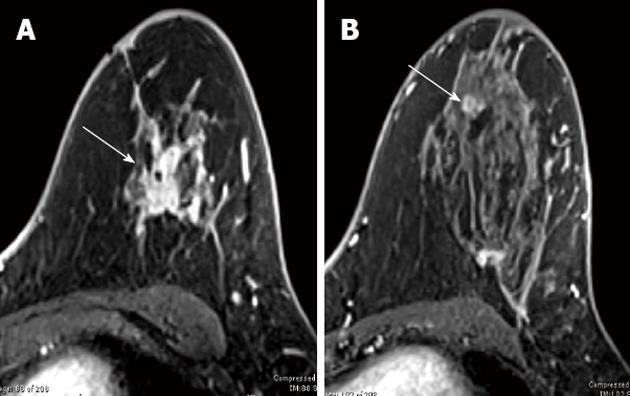Copyright
©2013 Baishideng Publishing Group Co.
World J Radiol. Aug 28, 2013; 5(8): 285-294
Published online Aug 28, 2013. doi: 10.4329/wjr.v5.i8.285
Published online Aug 28, 2013. doi: 10.4329/wjr.v5.i8.285
Figure 1 3.
0Tesla axial T1-weighted fat-suppressed contrast enhanced images in 62-year-old woman with newly diagnosed left breast infiltrating ductal carcinoma show the index cancer with signal void due to biopsy marker (long arrow) in the superior lateral quadrant and a second mammographically occult multicentric lesion shown to represent DCIS (short arrow) in the superior medial quadrant (A), an additional multicentric lesion proven to represent an additional infiltrating ductal carcinoma (arrow) in the inferior lateral quadrant (B), and a suspicious contralateral lesion (arrow) confirmed as a benign papilloma (C).
Figure 2 1.
5Tesla axial T1-weighted fat-suppressed contrast enhanced subtraction images in 53-year-old woman with newly diagnosed left breast infiltrating ductal carcinoma show a conglomerate of masses with signal void due to biopsy marker (arrow) in the left superior breast (A), and a mammographically occult rim-enhancing lesion (arrow) 2 cm inferior to the index cancer confirmed as an additional infiltrating ductal carcinoma (B). Note the lower contrast and spatial resolution evident on these images compared to the 3.0Tesla system.
- Citation: Butler RS, Chen C, Vashi R, Hooley RJ, Philpotts LE. 3.0 Tesla vs 1.5 Tesla breast magnetic resonance imaging in newly diagnosed breast cancer patients. World J Radiol 2013; 5(8): 285-294
- URL: https://www.wjgnet.com/1949-8470/full/v5/i8/285.htm
- DOI: https://dx.doi.org/10.4329/wjr.v5.i8.285










